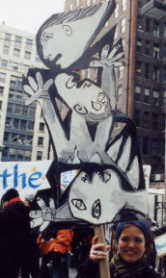
A final note about the recent Minotauromachie conference. Or rather about the Q & A which followed, in which one lugubrious chap posed the question, rhetorical no doubt, to the distinguished panelists: what would Picasso have thought about Iraq? At the time I confess to having been a bit annoyed by the question. Here we were discussing the meanings of Picasso’s work on an ethereal level, aspiring to the universal meanings he achieved and not getting bogged down in mundane matters such as politics.
Yet, frankly, the Bush administration forced the issue by covering the tapestry reproduction of Picasso’s Guernica, which hangs at the entrance of the U.N. Security Council, in preparation for Colin Powell’s fateful call to war. Someone in our government apparently had enough culture to perceive that Guernica is an anti-war statement. Perhaps he knew that it is THE iconic anti-war statement of the last century. Too bad, though, that the UN, whose prime directive is world peace, capitulated to censorship of its anti-war message, if indeed it had any choice—after all, it is housed on American soil—to accommodate American war mongering.
The U.S. has a long history of censorship of art. Many public sculptures have been rejected, and many art exhibitions have been edited, in order to protect the purported innocence of our people. (Check out the fascinating history of this subject in the very well written book, Visual Shock, by Michael Kammen.) Yet most prior instances of such censorship were spurred by the sexual content of the art, no doubt a holdover of our ancestral Puritanical prudishness.
As for Picasso, we all know what he would have said. He might have even painted a picture, as he did for the Korean War. One hopes that the Maestro’s exhortation for peace would not have fallen on deaf ears.
At least some New Yorkers noticed the flagrant violation of Picasso’s anti-war message. Note the photo of their protest above.